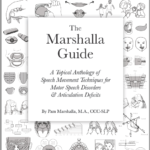Article Review: How Well Can Children Recognize Speech Features in Spectrograms? Comparisons by Age and Hearing Status

Article Review
By Guest Blogger Kayla Perry
Title of Article
How Well Can Children Recognize Speech Features in Spectrograms? Comparisons by Age and Hearing Status
Author: David J. Ertmer Purdue University, West Lafayette, IN
Synopsis: Real-time spectrographic displays (SDs) have been used in speech training for more than 30 years with adults and children who have severe and profound hearing impairments. Despite positive outcomes from treatment studies, concerns remain that the complex and abstract nature of spectrograms may make these speech trainingaids unsuitable for use with children. This investigation examined how well children with normal hearing sensitivity and children with impaired hearing can recognize spectrographic cues for vowels and consonants, and the ages at which these visual cues are distinguished. Sixty children (30 with normal hearing sensitivity, 30 with hearing impairments) in 3 age groups (6–7, 8–9, and 10–11 years) were familiarized with the spectrographiccharacteristics of selected vowels and consonants. The children were then tested on their ability to select a match for a model spectrogram from among 3 choices. Overall scores indicated that spectrographic cues were recognized with greater-than-chance accuracy by all age groups. Formant contrasts were recognized with greater accuracy than consonant manner contrasts. Children with normal hearing sensitivity and those with hearing impairment performed equally well.
Full article was published in the Journal of Speech, Language, and Hearing Research Vol.47 484-495 June 2004. doi:10.1044/1092-4388(2004/038)
© American Speech-Language-Hearing Association
Summary
Although there have been positive outcomes from treatment studies regarding the use of spectrograms in speech training, there is speculation over whether or not spectrograms are suitable speech training aids to use with children. This study examined how well children with normal hearing sensitivity and children with hearing impairment can recognize spectrographic cues for vowels and consonants and the ages in which these visual cues are distinguished. There were sixty children involved, thirty of which had normal hearing sensitivity and thirty of which had hearing impairments. They were then broken up into three age groups (6-7 years, 8-9 years and 10-11 years). They were previously familiarized with the spectrographic representations and characteristics of the selected phonemes. The children were tested on their ability to select a match for a model spectrogram based on three choices. The results indicated that all of the age groups recognized the spectrographic cues with greater- than- chance accuracy. Overall, both children with normal hearing sensitivity and children with hearing impairments preformed equally.
Class Comparison
In class, we have studied spectrographic representation of various phonemes. In this study, the children had to identify various phonemes on spectrographic displays. These familiar phonemes included phonemes from various consonant manner classes, including stops, nasals, fricatives, affricates, glides and liquids and phonemes from three vowel categories including point, central and middle. In class, we have viewed and discussed the structure of both the consonant manner classes and the vowel categories. The children had to identify vowels, which means that they had to be able to recognize the formants and the formant transitions. They also had to identify the different consonant manner classes and the specific characteristics that come with each of those spectrograms. For example, in both our class time and the study, they had to be able to recognize the stop gap, release burst and formant transition in a spectrogram for a stop. Another comparison to our class time, are the techniques that are used to remember the characteristics of specific phoneme spectrograms. In class, we were given some ways to remember how to identify frication and noise in spectrograms (tree bark). In the study, the children were given some terms to help them identify certain characteristics (fat bushy, skinny bushy). These terms used are in layman terms and often make it easier for individuals to understand and recognize the characteristics.
Critical Opinion
Overall, I think that there were a few things in this study that could use some improvement. First of all, I believe that there are some things regarding the training procedure that could use some improvement. They began by projecting various spectrographic displays for the children and pointing out the characteristics of each. Then, they instructed the children about specific consonant and vowel groups and described each one individually to the child. Then they provided the child with analogies to help them recognize the certain characteristics to then be able to identify the phoneme presented. I believe that in the process of training the children, they may have created a situation in which the children memorize the characteristics of the spectrogram, instead of actually getting a full understanding of the information and phoneme that they were looking at. Also, they did mention that the age groups were chosen based on the fact that the children were elementary school age and at an age in which they could sustain attention during the training and procedure. I think they should have included children under the age of 6, because there are children younger than 6 who receive speech services, who may have to use spectrographic displays in their treatment. Overall, I think this article and study was successful, especially considering young children were the subject. There are a few things that I think they could have done differently, but in conclusion this was an effective study in finding that spectrographic displays are suitable speech training aids for children.







